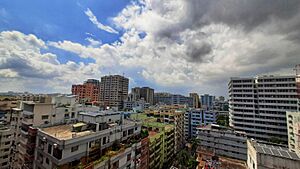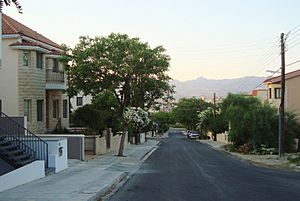Neighbourhood facts for kids

A neighbourhood (or neighborhood) is a specific area where people live. It's like a small community inside a bigger city, town, or even a suburb. Sometimes, a neighbourhood can be just one street and the buildings on it.
People in a neighbourhood often know each other. They might talk, help each other, and share common interests. Think of it as a place where people live close enough to interact regularly.
Contents
Neighbourhoods in History
In the past, neighbourhoods were very important. They often formed naturally as people lived near each other. Even in the earliest cities, archaeologists have found signs of these social groups.
How Old Cities Used Neighbourhoods
In many old cities, neighbourhoods handled some basic tasks. Things like keeping the area clean or helping with births and marriages were often managed by the people living there. City leaders didn't always control these small areas directly. This was common in historical Islamic cities, for example.
Official Areas vs. Neighbourhoods
Most ancient cities also had official areas called administrative districts. These were used by leaders for things like collecting taxes or keeping records. These official districts were usually larger than neighbourhoods. Their borders might even cut through different neighbourhoods.
Sometimes, an official district was the same as a neighbourhood. This meant that city officials had a lot of control over daily life. For instance, in the Chinese capital city of Chang'an during the Tang period, officials closely watched activities in each neighbourhood.
Special Neighbourhoods
Neighbourhoods in old cities often had special groups of people.
- Ethnic neighbourhoods were common. People from the same background lived together. This still happens in cities today.
- Economic neighbourhoods had people who did the same kind of work. For example, all the craft makers or merchants might live in one area.
- Religious neighbourhoods formed when people of the same religion lived close to each other.
People often moved from the countryside to cities. They usually moved in with family or friends from their old homes. This helped make neighbourhoods unique and brought people closer together.
Studying Neighbourhoods
Sociology is the study of how people live in groups. Neighbourhood sociology is a part of this field. It looks at how local communities work. Some experts also see neighbourhoods as small democracies. Here, neighbours work together and help each other out.
Improving Neighbourhoods
Neighbourhoods are often where local services are provided. This helps make sure people get good services close to home. It also gives local people more say in how things are run.
Community Development
Groups like Community Development Corporations work to improve neighbourhoods. They help fix up homes and build community centres. These groups often work with local leaders and even faith-based organizations. Their goal is to make the community a better place to live.
Neighbourhoods in City Planning
In the 1900s, a planner named Clarence Perry came up with the idea of a neighbourhood unit. This was a self-contained living area within a city. This idea is still important today in a planning style called New Urbanism. This style tries to bring back the friendly, social feel of older neighbourhoods in new housing areas.
City planners also study neighbourhoods to help older adults. They want to create "Age-Friendly Cities and Communities." This means making sure older people can easily get around and find what they need close to home.
Neighbourhoods Around the World
Asia

China
In mainland China, a neighbourhood is an official administrative division. It's usually found below the district level. These areas are sometimes called "streets." A Chinese neighbourhood can include 2,000 to 10,000 families.
Within these neighbourhoods, families are grouped into smaller residential units. These units have about 100 to 600 families. A "residents' committee" supervises these units. These committees then divide into even smaller groups of fifteen to forty families.
In most Chinese cities, words like neighbourhood, community, and residential unit mean the same thing. They refer to the direct sublevel of a subdistrict. A subdistrict is below a district, which is below a city.
Europe

United Kingdom
In the United Kingdom, the term "neighbourhood" isn't an official term for statistics. However, local councils often use it for smaller parts of their area. They use these areas to deliver services. For example, you might hear about "neighbourhood policing" or Neighbourhood watch schemes.
Government statistics for local areas are often called "neighbourhood statistics." But the actual data is usually broken down into districts and wards. In many parts of the UK, wards are similar to neighbourhoods or a combination of them.
North America
In the United States and Canada, neighbourhoods often have official status. This happens through groups like neighbourhood associations or neighbourhood watches. These groups might set rules for things like lawn care. They can also organize fun events like block parties or provide services like neighbourhood parks and community security.
In some places, a parish is similar to a neighbourhood. However, a parish might contain several neighbourhoods.
When neighbourhoods don't have official status, it can be hard to know where one begins and another ends. Many cities use "districts" and "wards" as official divisions instead of traditional neighbourhood boundaries. ZIP Code boundaries and post office names can also sometimes show where neighbourhoods are.
See also
 In Spanish: Barrio para niños
In Spanish: Barrio para niños


